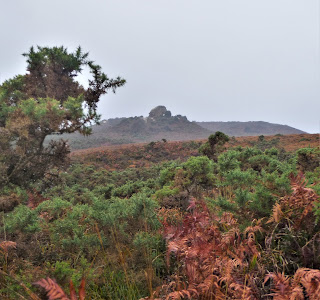In the last post I described my visit to Lanyon Quoit, an iconic dolmen in Penwith, on 13th September. Then I went to see the Cheesewring, an impressive stack of granite slabs on Bodmin Moor, on 23rd September, the subject of another fairly recent post. But that wasn't the end of it. On 30th October I braved some rather wet weather to take a close look at the Agglestone, a big sandstone rock on heathland near Studland on the Isle of Purbeck in Dorset.
Having parked at Studland, I posed in front of a mirror to record the off-putting wetness of the afternoon.
The rain was clearly going to be relentless. But I was looking forward to the two-to-three mile walk to the Agglestone and back, and wasn't going to be put off. I'd never seen it before, and wouldn't get another chance during the current holiday, my last of the year. According to the Ordnance Survey map, the route was clear and straightforward.
Mind you, some of the signposting on the way was hard to read - such as this hoary old finger-post.
After negotiating some waterlogged paths - easy with the trusty Dubarry boots on my feet - I got my first distant glimpse of the Agglestone, a blob of rock on a knoll.
Encouraged, and with the rain temporarily lessening, I just followed the obvious path. It was a bit of an upward scramble at the end, but then I was up there with the Agglestone before me. It seemed imposing at close quarters.
I allowed myself a small moment of pleasure. Another destination clocked up!
What one sees now is not how the Agglestone used to be. It stood tall, horizontal, and anvil-shaped as recently as 1970. But gradual erosion had made it unstable, and in 1970, fifty years ago, it toppled over onto one side. Apparently it had weighed 400 tons, and by the look of things, significant parts of it broke off in the fall. It must have made a pretty loud noise as it hit the ground and cracked apart. I hope nobody was nearby - they would have had the fright of their lives! However, despite its fallen state, the Agglestone remains most impressive.
I walked slowly around it. Iron in the rock had stained the lower parts ochre yellow and pink-red. These are similar to the vivid colours you see at Alum Bay, at the far west end of the Isle of Wight, on the other side of Bournemouth Bay. I expect the geology is much the same.
It was very breezy up on that knoll - not especially cold, but I was glad to be wearing my green, fleece-lined, waterproof, hooded Seasalt raincoat! I was cosy enough.
The rain had stopped while I took my photos, but now it began again. Time to go. There was a clear path that dropped down the far side of the knoll, then bore around clockwise, making a loop that eventually rejoined the way I'd came. I took it. On the way back, the map told me that I'd see a smaller rock called the Puckstone. How nice! The chance of two heathland landmarks!
As I walked, I looked back at the Agglestone, which now resembled a sitting bullfrog in the failing light.
The rain got more and more insistent, making visibility poor. Still, I was pretty confident of spotting the Puckstone. I was following the map very closely. It was supposed to be just off the path - I could hardly miss it.
But where was it? Well, I think Puck himself must have bewitched my eyes, as try as I might, I couldn't spot it. I can only assume that it didn't stick out much from the ground, and was hidden by all the gorse, ferns and bracken, so that I walked by unknowing. Or else mischievous Puck took it away for the day, so that I wouldn't find it, and then put it back once I'd gone.
Never mind. The Agglestone had been my major objective, and I could definitely say 'mission accomplished'. Next time, though, I'll go and see it on a warm and dry summer's day. If there is a next time, that is. I'm not sure it was quite rewarding enough.
























